
Newtec M6100 Manuals
Manuals and User Guides for Newtec M6100. We have 3 Newtec M6100 manuals available for free PDF download: User Manual, Quick Start Manual
Advertisement
Newtec M6100 Quick Start Manual (2 pages)
Broadcast Satellite Modulator
Advertisement
Advertisement


